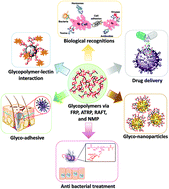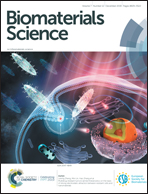Recent progress of glycopolymer synthesis for biomedical applications
Abstract
Glycopolymers are an important class of biomaterials which include carbohydrate moieties in their polymer structure. In addition to biological research on the interactions of glycopolymers with lectin-carbonate, glycopolymers have recently been used as a new synthetic biomaterial for direct therapeutic methods, medical adhesives, and biosensors. Thus, a comprehensive understanding of new advances in glycopolymer research is essential for the next level of biomaterial studies. This review article highlights commonly used glycopolymer synthesis methods and biomedical applications thereof. Glycopolymers can be synthesized by modern polymerization methods that can control the molecular weight, molecular weight distribution, chemical functionality, and polymer architecture. The polymerizations include free radical polymerization, atom transfer radical polymerization, reversible addition–fragmentation chain-transfer polymerization, and nitroxide-mediated polymerization. Because the carbohydrate–lectin interactions with glycopolymers are involved in many biological processes, carbohydrates containing glycopolymers are used in (1) fundamental studies to understand the specificity and strength of biological binding, (2) controllable interactions to prevent microorganism adhesion to human cells, (3) large scale bulk adhesives for medical applications, (4) biocompatible therapeutic nanoparticles, (5) direct drug delivery vehicles, and (6) precise quantitative measurement of biosensor materials that can detect physiological signals.



 Please wait while we load your content...
Please wait while we load your content...